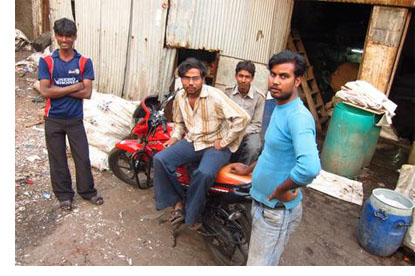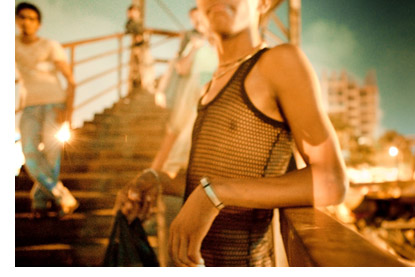Mumbai Inspired
By Collin Dunbar
Editor’s Note: In Art New England’s latest issue, we followed a young Boston artist Alex White-Mazarella and his colleagues as they completed an art and urban planning project in the city of Mumbai called Artefacting Mumbai. Writer Collin Dunbar updates and elaborates on this evolving story.
 The Indian city of Mumbai is the second largest city in the world, and one of its tiniest districts, Dharavi, is one of the most densely populated areas anywhere. There are no accurate census figures, but it is estimated that anywhere from 600,000 to one million Indians make their home in the district, which is little more than half-a-square-mile. Dharavi is often referred to as “Asia’s largest slum,” and prominently featured in British director Danny Boyle’s Academy Award winning film Slumdog Millionaire.
The Indian city of Mumbai is the second largest city in the world, and one of its tiniest districts, Dharavi, is one of the most densely populated areas anywhere. There are no accurate census figures, but it is estimated that anywhere from 600,000 to one million Indians make their home in the district, which is little more than half-a-square-mile. Dharavi is often referred to as “Asia’s largest slum,” and prominently featured in British director Danny Boyle’s Academy Award winning film Slumdog Millionaire.
The artists of Artefacting Mumbai, an art exhibition staged in the heart of the district, pointedly disagree with popular characterizations of Dharavi as a “slum.” White-Mazarella says in a Q & A with the Sunday Guardian, “Stepping into Asia’s biggest slum meant holding my shoulder bag in front of me and snapping around to see who was behind me. Now it’s three months later and it’s clear there is no danger here. The journey has evolved and I have evolved into a state of mind I won’t really be fully cognizant of until I return to where I came from.”
White-Mazarella originally envisioned Artefacting Mumbai as a way to intersect two primary disciplines he had studied in college: urban planning and art. Then he approached his friend and fellow urbanist/artist Casey Nolan, also a videographer and photographer, with his ideas. White-Mazarella and Nolan met their third collaborator as he was building sets for the Rolling Stones, during one of their American tours; Arne de Knegt, like his American colleagues, is educated in urban planning and makes his living as a travel photographer. Together, the three laid the groundwork for this astonishing exhibition, a multimedia extravaganza staged in the heart of Dharavi.
 After recruiting Mumbai natives Parasher Baruah, a documentarian and Nishant Nayak, a video artist, the team headed to Mumbai in late 2010 to early 2011 to make their vision a reality. White-Mazarella described the intentions of the Artefacting team to the Guardian: “The main aim of Artefacting Mumbai is to use art to create a dialogue and rethink the way we see or think about those people on ‘the other side’… in this case it’s the ‘slum’ of Dharavi. Artefacting Mumbai is about using art to engage the marginalized communities of Dharavi and feel it out from the inside… it’s about breaking down outsiders preconceived notions of Dharavi—a place many local Mumbaikers refer to as the ‘black’ place—by going beyond its rusty surface and telling intimate stories. It is about examining Western culture and confronting our fears through creating narrative art and media that can initiate relevant and meaningful discussion.”
After recruiting Mumbai natives Parasher Baruah, a documentarian and Nishant Nayak, a video artist, the team headed to Mumbai in late 2010 to early 2011 to make their vision a reality. White-Mazarella described the intentions of the Artefacting team to the Guardian: “The main aim of Artefacting Mumbai is to use art to create a dialogue and rethink the way we see or think about those people on ‘the other side’… in this case it’s the ‘slum’ of Dharavi. Artefacting Mumbai is about using art to engage the marginalized communities of Dharavi and feel it out from the inside… it’s about breaking down outsiders preconceived notions of Dharavi—a place many local Mumbaikers refer to as the ‘black’ place—by going beyond its rusty surface and telling intimate stories. It is about examining Western culture and confronting our fears through creating narrative art and media that can initiate relevant and meaningful discussion.”
The team also conducted art classes for at-risk Dharavian children under the auspices of ACORN, a local NGO. The installations themselves consist of hundreds of drawings by White-Mazarella, photographs by de Knegt and Nolan, and Nolan’s video collages, which are displayed, projected and intermingled in various ways throughout the installation space. The installation’s site is the Thirteenth Ward, adjacent to a facility where about 10,000 workers recycle eighty percent of the city’s waste, and recycling is one of the thematic cornerstones of the Artefacting installation.
The artists collaborated with Dharavians to use recycled wax from Indian artist Anish Kapoor’s recent exhibition to recreate Kapoor’s piece Shooting into the Corner. Kapoor also hosted Dharavian children from the program at a showing of his art, and donated fifty signed photos of Shooting to be sold to fund scholarships for the children. Segments of Artefacting Mumbai will be shown in galleries in New York and Portland, Oregon. In early 2012, White-Mazarella plans to also show the work at the Cambridge Multicultural Arts Center.
Read about the exhibit in the Sunday Guardian and in the Wall Street Journal blog India Real Time.
